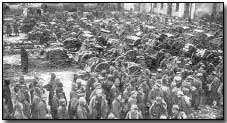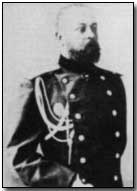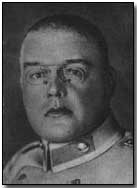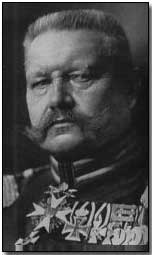Battles - The Battle of Tannenberg, 1914
 Perhaps the most spectacular and complete
German victory of the First World War, the encirclement and destruction of
the Russian Second Army in late August 1914 virtually ended Russia's
invasion of East Prussia before it had really started.
Perhaps the most spectacular and complete
German victory of the First World War, the encirclement and destruction of
the Russian Second Army in late August 1914 virtually ended Russia's
invasion of East Prussia before it had really started.
Russia's incursion into German territory was two-pronged. General Samsonov had begun to take his Second Army into the south-western corner of East Prussia whilst General Rennenkampf advanced into its north-east with the First Army. The two armies planned to combine in assaulting General Prittwitz's German Eighth Army, Rennenkampf in a frontal attack while Samsonov engulfed Prittwitz from the rear.
Such was the Russians' initial plan. Rennenkampf brought about a modification however following a scrappy victory against Eighth Army at the Battle of Gumbinnen, after which he paused to reconsolidate his forces.
Prittwitz, shaken by the action at Gumbinnen and fearful of encirclement, ordered a retreat to the River Vistula. Upon receipt of this news Helmuth von Moltke, the German Army Chief of Staff, recalled Prittwitz and his deputy von Waldersee to Berlin - an effective dismissal - and installed as their replacement the markedly more aggressive combination of Paul von Hindenburg - brought out of retirement at the age of 66 - and Erich Ludendorff as his Chief of Staff (having earlier distinguished himself at Liege).
Upon his arrival in East Prussia on 23 August Hindenburg immediately reversed Prittwitz's decision to withdraw, choosing instead to authorise a plan of action prepared by Colonel Maximilian Hoffmann, Prittwitz's deputy chief of operations. While Hindenburg and Ludendorff received much credit for the subsequent action at Tannenberg, the actual plan of attack was devised in detail by Hoffmann.
 Hoffmann proposed a ploy whereby cavalry
troops would be employed as a screen at Vistula, the intention being to
confuse Rennenkampf who, he knew, held a deep personal vendetta with
Samsonov (who had complained of Rennenkampf's conduct at
the Battle of Mukden in 1905) and so would be
disinclined to come to his aid if he had justifiable cause not to.
Hoffmann proposed a ploy whereby cavalry
troops would be employed as a screen at Vistula, the intention being to
confuse Rennenkampf who, he knew, held a deep personal vendetta with
Samsonov (who had complained of Rennenkampf's conduct at
the Battle of Mukden in 1905) and so would be
disinclined to come to his aid if he had justifiable cause not to.
Meanwhile, General Hermann von Francois's I Corps were transported by rail to the far southwest to meet the left wing of Samsonov's Second Army. Hindenburg's remaining two corps, under Mackensen and Below, were to await orders to move south by foot so as to confront Samsonov's opposite right wing. Finally, a fourth corps was ordered to remain at Vistula to meet Samsonov as his army moved north. The trap was being set.
Samsonov meanwhile, bedevilled by supply and communication problems, was entirely unaware that Rennenkampf had chosen to pause and lick his wounds at Gumbinnen, instead assuming that his forces were continuing their movement south-west.
Samsonov was similarly unaware of Hoffmann's plan or of its execution. Assured that his Second Army was en route to pursue and destroy the supposedly retreating Eighth Army (and supported in doing so by overall commander Yakov Zhilinski, who was subsequently dismissed for his part in the following debacle), he continued to direct his army of twelve divisions - three corps - in a north-westerly direction towards the Vistula. The remaining VI Corps he directed north towards his original objective, Seeburg-Rastenburg.
On 22 August the bulk of Samsonov's forces reached the extremities of the German line, fighting (and winning) small actions as it continued to advance into the German trap of encirclement.
Ludendorff issued an order to General Francois to initiate the attack on Samsonov's left wing at Usdau on 25 August. Remarkably, Francois rejected what was clearly a direct order, choosing instead to wait until his artillery support was in readiness on 27 August. Ludendorff - along with Hoffmann - travelled to see Francois and to repeat the order. Reluctantly, Francois agreed to commence the attack, but complained of a lack of shells.
Whilst returning from their meeting with Francois, Hoffmann was passed two intelligence intercepts that had been transmitted by Rennenkampf and Samsonov, respectively, in the clear, i.e. unciphered. Their contents were explosive.
The first, sent by Rennenkampf, revealed the distance between his and Samsonov's armies. It further detailed his First Army's imminent marching plans, and these were not towards Samsonov's Second Army.
The import of the message was clear: the Germans need not fear intervention from the Russian First Army during their assault upon Samsonov's forces. The second intercepted message, from Samsonov, was similarly remarkable.
Having engaged - unsuccessfully - the heavily entrenched German XX Corps the previous day, 24 August, at the Battle of Orlau-Frankenau, Samsonov had noted what he took to be a general German withdrawal to Tannenberg and beyond. Consequently, his message provided detailed plans for his intended route of pursuit of the German forces.
 With both messages in hand, Hoffmann
promptly hurried after Ludendorff and Hindenburg and handed them the
intercepts. While Ludendorff was sceptical as to their authenticity,
Hindenburg, having heard Hoffmann tell of the personal quarrel between
Rennenkampf and Samsonov, was inclined to alter the German Eighth Army's
plans accordingly.
With both messages in hand, Hoffmann
promptly hurried after Ludendorff and Hindenburg and handed them the
intercepts. While Ludendorff was sceptical as to their authenticity,
Hindenburg, having heard Hoffmann tell of the personal quarrel between
Rennenkampf and Samsonov, was inclined to alter the German Eighth Army's
plans accordingly.
It was argued by Hindenburg and Hoffmann that Francois could, after all, await the arrival of sufficient artillery supplies before beginning his attack at Usdau, which in the event came two days later, on 27 August. Ludendorff, keen to assert his authority over Francois, insisted that the attack begin as originally scheduled.
Francois however had no intention of attacking without artillery support. Buying time he fell to bickering with Ludendorff and, as he intended, began his attack, by I Corps, on 27 August - and rapidly enjoyed marked success. Rapidly taking Soldau on the Russian border, and so cutting communication with Samsonov's centre, his forces confined Samsonov's left to the frontier.
Despite his success, Francois did not enjoy the trust of either Hindenburg nor, especially, Ludendorff again, particularly once they both moved to Berlin to take over the direction and conduct of the war.
At this stage Ludendorff, fearful that Rennenkampf's forces might yet suddenly join the fray, ordered Francois to move back north, another order ignored by Francois, who chose instead to take his corps east so as to prevent Samsonov's centre from retreating over the border. Although executed in disobedience of Ludendorff's clear order, his bold action contributed to the sweeping success that followed.
Helmuth von Moltke, the German Army Chief of Staff in Berlin, was similarly nervous of the German Army's prospects in the east. He astonished Ludendorff by telephoning him with notification that he was dispatching a cavalry division and three corps from the west to bolster the Eastern Front. Aware that the troops could be ill-afforded by the weakened German attack towards Paris - that is, by the precisely calculated execution of the Schlieffen Plan - Ludendorff protested that the reinforcements were unnecessary. Nevertheless they were sent.
Having decided on 25 August - the day he was passed the Russian radio intercepts - that Rennenkampf's forces were unlikely to attempt to join Samsonov Ludendorff sent the two corps stationed at Gumbinnen south where on the following day they met and brought into action Samsonov's VI Corps moving northwards at Bischofsburg. Surprised and disorganised, both divisions retreated separately for the Russian border.
Ignoring warnings of a massed German advance moving south, Zhilinksi directed Rennenkampf's First Army to the west to Konigsberg on 26 August, a considerable distance from Samsonov's plight. Given the degree of personal enmity between Rennenkampf and Samsonov - they had physically come to blows on at least one occasion - the former had no particular inclination to come to Samsonov's assistance.
Disastrously for Samsonov, Hoffmann and Ludendorff intercepted Zhilinksi's unciphered order to Rennenkampf. He promptly dispatched Below from Bischofsburg to rejoin the German centre, and sent Mackensen south to meet up with General Francois, where they joined in Willenberg, south of Bischofsburg, on 29 August. Samsonov was by now surrounded.
At last, on 28 August, Samsonov finally became aware of the peril he faced. Critically short of supplies and with his communications system in tatters, his forces were dispersed, and VI corps had already been defeated. Consequently he ordered a general withdrawal on the evening of 28 August.
 It was too late for Samsonov's forces, as they
scattered - many throwing down their weapons and running - directly into the
encircling German forces. Relief from the Russian border in the form
of counter-attacks were weak and insufficient.
It was too late for Samsonov's forces, as they
scattered - many throwing down their weapons and running - directly into the
encircling German forces. Relief from the Russian border in the form
of counter-attacks were weak and insufficient.
95,000 Russians troops were captured in the action; an estimated 30,000 were killed or wounded, and of his original 150,000 total, only around 10,000 of Samsonov's men escaped. The Germans suffered fewer than 20,000 casualties and, in addition to prisoners captured over 500 guns. Sixty trains were required to transport captured equipment to Germany.
Samsonov, lost in the surrounding forests with his aides, shot himself, unable to face reporting the scale of the disaster to the Tsar, Nicholas II. His body was subsequently found by German search parties and accorded a military burial.
Hindenburg and Ludendorff were feted as heroes at home in Germany. Such was the lustre of the victory - combined with later albeit lesser successes at the First and Second Battles of the Masurian Lakes, that Hindenburg later replaced Erich von Falkenhayn as German Chief of Staff, bringing with him to Berlin Ludendorff as his quartermaster general.
A great propaganda victory, the scale of the Russian defeat shocked Russia's allies, who wondered whether it signalled the defeat of the Russian army. Such was not the case, as was demonstrated by the lesser scale of German victories at the Masurian Lakes. As always, the sheer weight of the Russian army ensured its survival. Even so, no Russian army penetrated German territory again until the close of the Second World War, in 1945.
Click here to read General von Hindenburg's summary of the battle. Click here to read Russian commander Vasily Gurko's summary. Click here to view film footage of captured Russian prisoners following the battle. To view maps charting the course of the battle click here; here; here; and here.
Photographs courtesy of Photos of the Great War website
"Toc Emmas" was slang for trench mortars.
- Did you know?
